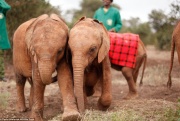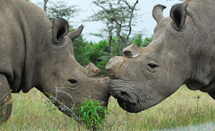Who are the Black Mambas? Meet the Female Anti-Poaching Unit of Greater Kruger
Who are the Black Mambas of Greater Kruger National Park?
The black mamba is one of Africa’s deadliest and most feared snakes. By contrast, the Black Mambas is a female anti-poaching unit dedicated to conservation. It was founded by Transfrontier Africa NPC in 2013 to protect the Olifants West section of Balule Nature Reserve, which forms part of the Greater Kruger National Park. The unit soon proved to be effective and was asked to expand its realm to protect all the boundaries of Balule.
Comprising 32 women and two men from the area, the Black Mambas protect the rhinos on the ground. Due to their gender and the successes they have attained, they have become the darlings of the media; practically all the media houses have done stories on them. In 2022 a documentary by Lena Korbe was shot that portrays the strength of the women who comprise this unit.
The women are role models for the girls and women in their community and provide a voice for conservation and its benefits, to counter the ‘false economy’ of poaching.
About Poaching in South Africa
According to environmentalists at Greentumble, there are less than 27,000 rhinos left in the wild, about half of which are in South Africa. The poaching crisis is driven mainly by the demand of Asian markets, where the horn is cherished for its (totally unproven) 'medicinal' value. As a black rhino horn can sell for as much as $300,000 there, the incentive to poach rhinos is very strong.
Increasing protection efforts seem to be paying off, at least in some areas. According to this 2023 Black Mambas story by Jamie Fullerton, rhino poaching has been almost completely eliminated in Olifants West. This was due to the Black Mambas and because the rhinos in the area had been dehorned – an effective deterrent for poachers. The unit has won several awards for its valour and achievements.
Black Mambas Training
 Black Mamba Rangers (Left to Right) Thuli Sibuyi, Lukie Mahlake, NoCry Mzimba, Collet Ngobeni
Black Mamba Rangers (Left to Right) Thuli Sibuyi, Lukie Mahlake, NoCry Mzimba, Collet Ngobeni
The Mambas undergo three months of training, including theory, rigorous fitness training, learning surveillance practices, and survival tactics – in case one is stranded in the bush – which prepare them for the job. They also learn how to hide from the dangerous animals and poachers in Balule.
Each day begins with a parade and issuing of orders, army-style, and then the uniformed Mambas head off into the bush. Every member of the Black Mambas spends three weeks of each month patrolling through the Kruger, either on foot or by jeep. The concept behind it is that by being visible, the poachers are deterred – and it’s working.
 Black Mamba Ranger, Goodness Mhlanga confirming health of Rhino for the Rhino Conservation Project
Black Mamba Ranger, Goodness Mhlanga confirming health of Rhino for the Rhino Conservation Project
 On morning parade, Balule Nature Reserve
On morning parade, Balule Nature Reserve
Black Mamba Patrols
Each morning at first light groups head out to patrol the boundaries. At the last light, vehicle patrols are conducted. Known points of entry and popular waterholes for the rhinos are monitored and signs of poisoning are looked out for. One of the main roles of the Mambas is to gather intelligence, which is shared with other rangers.
 Black Mambas on patrol in Greater Kruger
Black Mambas on patrol in Greater Kruger
When snares are removed before animals get trapped this not only saves the animals from being snared but also, in the long run, stops people from setting snares, as there is no longer any reward. However, unemployment is rife in the Limpopo population on the Kruger’s western boundary, which has led to a surge in the bushmeat trade and in 2018 a tenfold increase in the amount of snares collected. According to a 2023 Mail & Guardian report nearly half of the Kruger staff is corrupt, which means poaching is becoming ever harder to contain.
 Black Mambas observation post.
Black Mambas observation post.
The Mambas conduct roadblocks and routine searches of both visitors and workers in the area to weed out any illegal or suspect items. They work unarmed deliberately (they do carry pepper spray), to help create a new conservation ethos that builds constructive relations between rangers and those who live near the Kruger. It’s a dangerous occupation – globally, nearly 500 rangers died on active duty in the last decade.
Black Mambas Work with the Community
The creation of strong bonds within the communities who live in and around Greater Kruger National Park and the promotion of a pro-environmental ethos, with a focus on social upliftment, helps to ensure ongoing conservation. Craig Spencer, founder and director of Transfrontier Africa, says those who live near conservation areas were mostly historically excluded from the benefits these areas generate, and have not seen themselves as custodians of natural heritage. To redress this requires a multipronged approach.
The Mambas have empathy for the unemployed in the communities they live in near the Kruger. To help feed the hungry, they grow vegetables and package them into parcels, which they pass out to surrounding communities, and sell to the lodges in the park.
 Black Mamba Ranger, Everjoy Mathebula, assisting with the Environmental Education Project (Bush Babies).
Black Mamba Ranger, Everjoy Mathebula, assisting with the Environmental Education Project (Bush Babies).
Bush Babies Program
One project is the Bush Babies program, run by the Black Mambas, which involves ten schools in the area surrounding Greater Kruger Park. During weekly visits to the schools, the children are taught the importance of conservation and protecting their environment for the long-term sustainability of the area.
The Black Mambas – many of them mothers themselves – teach the kids about poaching, its detrimental effects, and how they work to stop it. The top performing children are also taken on trips and Scout camps to the Kruger, which has an entrance fee beyond the reach of most locals.
 Environmental Education Project (Bush Babies)
Environmental Education Project (Bush Babies)
How to Help the Black Mambas
Basic salaries are paid through the Extended Public Works Program, but all other costs, of which there are many, are absorbed by Transfrontier Africa. They rely heavily on funding and donations to cover these costs, which include training, uniforms, equipment, food, vehicles, fuel and the Bush Babies program. To help, get hold of them on one of their social media channels:
Find out more about the Black Mambas on the Transfrontier Africa website or to support them go straight to their Donations Page.
It’s a cause well worth supporting to save these threatened African animals.
 Time for a drink, Kruger National Park
Time for a drink, Kruger National Park
[Original article by Briony Chisholm posted Nov 2017 | Rewritten by Derek Davey in Sept 2023]
If you liked this post, these trips cover similar ground…
- Greater Kruger Park Tented Camp Safari
- 4 Day Kruger Safari - Walking & Camping Safari
- 3 Day Greater Kruger Safari - Budget Balule Tented Lodge
- 4 Day Greater Kruger Safari - Budget Balule Tented Lodge
- 4 Day Greater Kruger Safari to Big 5 Balule Private Game Reserve
- 5 Day Kruger Safari to Balule Private Game Reserve


 Derek lives in Joburg, so any trips into the bush or along the coast border on being spiritual experiences. He is an author, editor, poet and a musician who enjoys cutting to the chase and discovering what lurks beneath the surface. Southern Africa has an endless wealth of hikes, trails and sights that keep him inspired.
Derek lives in Joburg, so any trips into the bush or along the coast border on being spiritual experiences. He is an author, editor, poet and a musician who enjoys cutting to the chase and discovering what lurks beneath the surface. Southern Africa has an endless wealth of hikes, trails and sights that keep him inspired.












